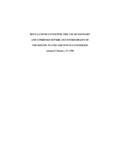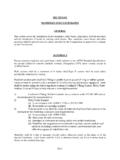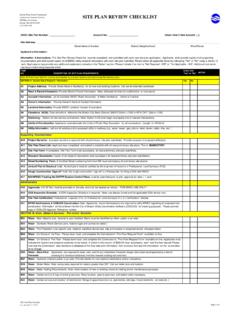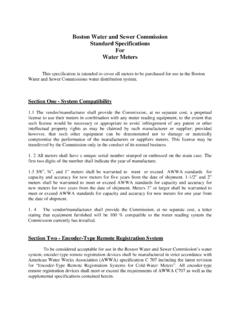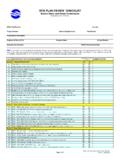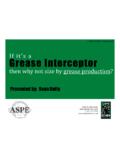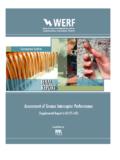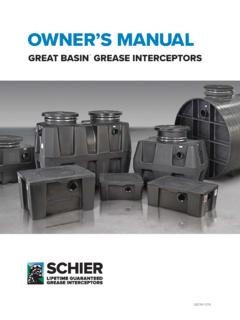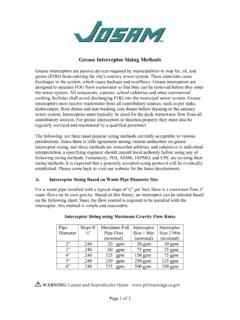Transcription of Can I Add Any Cleaning Agents Additional …
1 Boston Water and Sewer CommissionCan I Add Any Cleaning Agents to the Trap to Help Clear the grease Faster?No. Never add bleach, emulsifiers, enzymes, or any other chemical to the grease trap. These Agents harm the natural bacteria that eat grease and oils in grease traps. The only additive allowed into the sewer system by BWSC is bacteria. Bacteria consume fat, oil, and grease in the trap, turning them into water and carbon Methods of Disposal Are Available for Used grease ?The food establishment s waste hauler or renderer that removes used fryolator grease and oil normally accepts materials removed from the grease trap. Large in-ground grease traps normally hold 500 gallons or more and are usually cleaned by a contractor equipped to deal with the large quantities of grease , oil, and non-floatables.
2 It is the responsibility of the establishment owner to ensure the trap is completely May I Receive Assistance From BWSC When Cleaning the grease Trap in My Establishment?BWSC will provide grease Control Logs for the establishment owner to maintain regarding the Cleaning of the establishment s grease traps. The log notes the date the trap is cleaned, amount of material removed, and a signature confirming the work was maintenance of grease traps is essential to the smooth and sanitary operation of a food InformationFor Additional information regarding the proper maintenance and care of grease traps, please contact BWSC s Enforcement Division at Kitchen grease Trap GuidelinesBoston Water and Sewer CommissionCommunity Services Department 617-989-7000980 Harrison AvenueBoston, MA J.
3 WalshMayor, City of BostonHenry F. VitaleExecutive Director2013 grease Traps Are Required in Restaurants and Food EstablishmentsCooking grease that gets washed off cooking appliances and kitchenware can end up causing significant problems in building drains and BWSC sewers. BWSC s regulations governing the use of sanitary and combined sewers and storm drains require properly installed and maintained grease traps in all restaurants and food establishments in Boston. Article 111, Section 15, states: grease traps shall be required on sewers into which significant amounts of animal or vegetable fat, oil or grease may be discharged so that a discharge concentration does not exceed 100 milligrams per The Commission shall have the right to inspect such facilities in accordance with Article VII of these regulations.
4 For a complete copy of the regulations, go to (Regulations) or contact BWSC at Are grease Traps? grease traps are devices placed on kitchen Cleaning appliances such as sinks, woks, and any other drains that collect grease . Properly maintained grease traps help prevent unwanted grease build-up in a private building s sewer or a Boston Water and Sewer Commission (BWSC) There Different Types of grease Traps?Two types of grease traps exist:XTraps located in an establishment near the fixture it servesXLarge traps located outside the building in the ground that serve the entire kitchenWhat Fixtures in My Food Establishment Require a grease Trap?Significant amounts of grease in buildings and BWSC sewers can come from the following fixtures:XPot SinksXRinse Sinks at Dishwashers Note: Garbage disposals should not be installed on these Outside Trap Only Note: Dishwashers cannot flow through a point-of-use trap inside a Drains and SinksXAutomatic Hood WashersHow Do I Clean the grease Traps and How Often?
5 Note: These methods of Cleaning are for guideline purposes only; many traps are designed differently and require specific methods for Cleaning . Consult the equipment manufacturer for traps should be cleaned when 25% of the liquid level of the trap is grease or oil, once a month minimum for point-of-use traps, and quarterly for large in-ground grease cover should be removed carefully to avoid damage to the off the layer of grease and oil floating on top of the any baffles and scrape clean. After Cleaning , the baffles can be rinsed off in the sink that flows to the a strainer, scrape the bottom of the trap to remove all non-floatable food particles and the bypass vent with a flexible probe or baffles and : The grease trap should be completely emptied once a month.
6 Many establishments have an independent contractor that specializes in grease trap Cleaning perform the work. All interior grease trap installations are subject to state and local plumbing and solids from food establishments that enter a grease trap remain in the trap, separated from the water, which gets flushed to the sewer system. Periodically, the trap needs to be opened and the grease and solids removed to allow the trap to continue operating SinkVent LineFlowControlSolidsInterceptor(Optiona l)Air Relief Bypass

